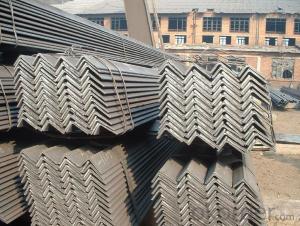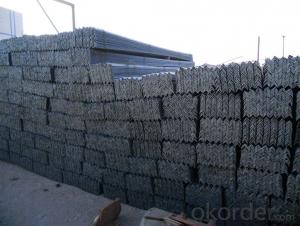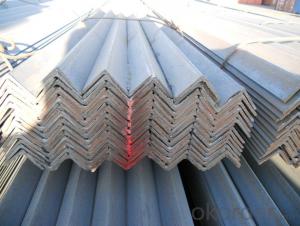Hot Rolled Unequal Angle Steel with High Quality
- Loading Port:
- Tianjin
- Payment Terms:
- TT or LC
- Min Order Qty:
- 100 m.t.
- Supply Capability:
- 35000 m.t./month
OKorder Service Pledge
OKorder Financial Service
You Might Also Like
OKorder is offering Hot Rolled Unequal Angle Steel with High Quality at great prices with worldwide shipping. Our supplier is a world-class manufacturer of steel, with our products utilized the world over. OKorder annually supplies products to African, South American and Asian markets. We provide quotations within 24 hours of receiving an inquiry and guarantee competitive prices.
Product Applications:
Hot Rolled Unequal Angle Steel with High Quality are ideal for structural applications and are widely used a variety of architectural and engineering structures, such as beams, bridges, ship; transmission tower, reaction tower; lifting transportation machinery; industrial furnace; container frame, warehouse goods shelves, etc
Product Advantages:
OKorder's Hot Rolled Unequal Angle Steel with High Quality are durable, strong, and wide variety of sizes.
Main Product Features:
· Premium quality
· Prompt delivery & seaworthy packing (30 days after receiving deposit)
· Can be recycled and reused
· Mill test certification
· Professional Service
· Competitive pricing
Product Specifications:
Grade: Q195 – 235
Certificates: ISO, SGS, BV, CIQ
Length: 6m – 12m, as per customer request
Packaging: Export packing, nude packing, bundled
| UNEQUAL ANGLE STEEL | |||||
| size(mm) | a(mm) | a1(mm) | thickness(mm) | kg/m | length(m) |
| 75*50*5 | 75 | 50 | 5 | 4.808 | 6m,9m,12m |
| 75*50*6 | 75 | 50 | 6 | 5.699 | 6m,9m,12m |
| 75*50*8 | 75 | 50 | 8 | 7.431 | 6m,9m,12m |
| 100*75*7 | 100 | 75 | 7 | 9.34 | 6m,9m,12m |
| 100*75*8 | 100 | 75 | 8 | 10.6 | 6m,9m,12m |
| 100*75*9 | 100 | 75 | 9 | 11.8 | 6m,9m,12m |
| 100*75*10 | 100 | 75 | 10 | 13 | 6m,9m,12m |
| 100*75*12 | 100 | 75 | 12 | 15.4 | 6m,9m,12m |
| 125*75*7 | 125 | 75 | 7 | 10.7 | 6m,9m,12m |
| 125*75*8 | 125 | 75 | 8 | 12.2 | 6m,9m,12m |
| 125*75*9 | 125 | 75 | 9 | 13.6 | 6m,9m,12m |
| 125*75*10 | 125 | 75 | 10 | 15 | 6m,9m,12m |
| 125*75*12 | 125 | 75 | 12 | 17.8 | 6m,9m,12m |
| 150*90*8 | 150 | 90 | 8 | 14.7 | 6m,9m,12m |
| 150*90*9 | 150 | 90 | 9 | 16.4 | 6m,9m,12m |
| 150*90*10 | 150 | 90 | 10 | 18.2 | 6m,9m,12m |
| 150*90*12 | 150 | 90 | 12 | 21.6 | 6m,9m,12m |
| 200*100*10 | 200 | 100 | 10 | 23 | 6m,9m,12m |
| 200*100*12 | 200 | 100 | 12 | 27.62 | 6m,9m,12m |
| 200*100*15 | 200 | 100 | 15 | 34.04 | 6m,9m,12m |
FAQ:
Q1: Why buy Materials & Equipment from OKorder.com?
A1: All products offered byOKorder.com are carefully selected from China's most reliable manufacturing enterprises. Through its ISO certifications, OKorder.com adheres to the highest standards and a commitment to supply chain safety and customer satisfaction.
Q2: How do we guarantee the quality of our products?
A2: We have established an advanced quality management system which conducts strict quality tests at every step, from raw materials to the final product. At the same time, we provide extensive follow-up service assurances as required.
Q3: How soon can we receive the product after purchase?
A3: Within three days of placing an order, we will arrange production. The normal sizes with the normal grade can be produced within one month. The specific shipping date is dependent upon international and government factors, the delivery to international main port about 45-60days.
Images:
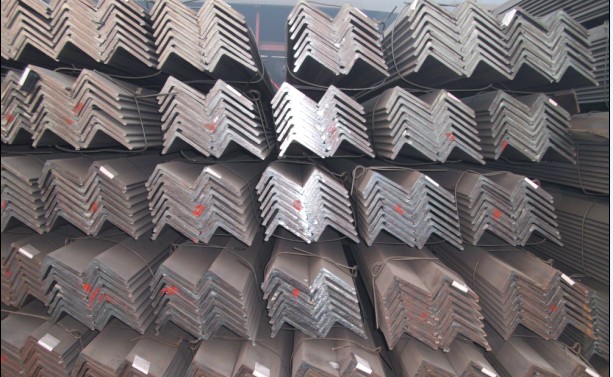

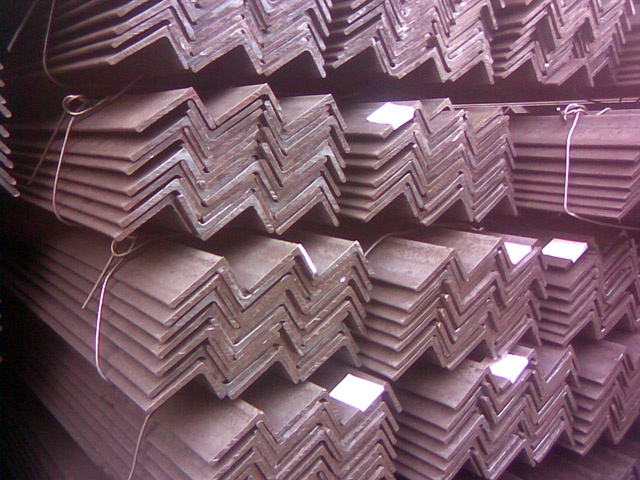
- Q:How do steel angles contribute to the sustainability of transportation systems?
- Steel angles contribute to the sustainability of transportation systems in several ways. Firstly, steel angles are widely used in the construction of infrastructure such as bridges, highways, and railway tracks. These structures have a longer lifespan and require fewer repairs and replacements compared to other materials, resulting in reduced maintenance costs and resource consumption. Moreover, steel angles are highly durable and resistant to harsh weather conditions, ensuring the longevity and safety of transportation systems. This durability minimizes the need for frequent repairs or replacement, reducing the overall environmental impact and carbon emissions associated with transportation infrastructure. Additionally, steel angles have a high strength-to-weight ratio, allowing for the design of lighter and more fuel-efficient vehicles. By using steel angles in the manufacturing of automobiles, trains, and ships, the weight of these vehicles can be reduced, leading to improved fuel efficiency and reduced greenhouse gas emissions during operation. Furthermore, steel angles can be easily recycled at the end of their life cycle. Steel is one of the most recycled materials globally, with a recycling rate of over 85%. Recycling steel angles not only reduces the demand for virgin steel production but also saves energy and reduces greenhouse gas emissions associated with the extraction and manufacturing processes. Overall, the use of steel angles in transportation systems contributes to their sustainability by promoting durability, reducing maintenance needs, improving fuel efficiency, and enabling efficient recycling. These factors collectively help to minimize the environmental impact and enhance the long-term viability of transportation infrastructure.
- Q:How do you calculate the deflection of a steel angle under load?
- To calculate the deflection of a steel angle under load, you can use the principles of structural engineering and the concept of beam deflection. The deflection of a beam is the degree to which it bends or sags under an applied load. Firstly, you need to determine the properties of the steel angle, such as its cross-sectional area, moment of inertia, and modulus of elasticity. These properties can be obtained from the manufacturer's specifications or through testing. Next, you should determine the type of loading the steel angle will be subjected to, such as a uniformly distributed load or a concentrated load. The magnitude and distribution of the load will affect the deflection. Once you have the necessary information, you can use various equations and formulas to calculate the deflection. One commonly used equation is the Euler-Bernoulli beam equation, which relates the deflection of a beam to the applied load, its length, and the properties of the material. The equation for calculating the deflection of a simply supported beam, such as a steel angle, under a uniformly distributed load is: δ = (5 * w * L^4) / (384 * E * I) Where: δ is the deflection w is the uniform load per unit length L is the length of the beam E is the modulus of elasticity of the steel angle I is the moment of inertia of the steel angle about its neutral axis For a concentrated load, the equation would be slightly different. Additionally, if the steel angle is not simply supported but has different boundary conditions, such as being fixed at one end, the equations will vary accordingly. It's important to note that these equations provide an estimate of the deflection, assuming the steel angle behaves linearly and elastically. In reality, there might be other factors affecting the deflection, such as material imperfections or non-linear behavior under high loads. Therefore, it is always recommended to consult a structural engineer or utilize specialized software for a more accurate and comprehensive deflection calculation.
- Q:Are steel angles magnetic?
- Yes, steel angles are magnetic as they are typically made from a type of steel that contains iron, which is a ferromagnetic material.
- Q:What are the different types of corrosion protection coatings for steel angles?
- For steel angles, there exists a variety of corrosion protection coatings that serve different purposes in safeguarding against corrosion. 1. Paint Coatings: Paint coatings are frequently employed for corrosion protection of steel angles. Acting as a barrier, they shield the steel surface from corrosive elements present in the surroundings. These coatings are typically applied in multiple layers and can be tailored to meet specific needs, such as resistance to chemicals or UV radiation. 2. Galvanizing: Another extensively used method for corrosion protection in steel angles is galvanizing. This process entails the application of a zinc layer to the steel surface through hot-dip galvanizing. By acting as a sacrificial anode, this coating provides excellent corrosion protection, sacrificing itself before the steel. Galvanized steel angles are commonly utilized in outdoor settings where exposure to moisture and harsh weather conditions is expected. 3. Powder Coatings: Powder coatings, which are applied as a dry powder and cured with heat, offer a durable and corrosion-resistant finish for steel angles. These coatings can be customized in terms of color, texture, and thickness, ensuring both aesthetic appeal and enhanced protection against corrosion. 4. Epoxy Coatings: Industrial applications often require the use of epoxy coatings when steel angles may be exposed to harsh chemicals or abrasive environments. These coatings form a robust and protective layer that resists corrosion, chemicals, solvents, and abrasion. They can be applied as a single layer or combined with other coatings for added protection. 5. Organic Coatings: In architectural applications where corrosion protection is necessary while maintaining an attractive appearance, organic coatings such as polyurethane or acrylic coatings are commonly used for steel angles. These coatings offer good resistance to weathering, UV radiation, and corrosion, ensuring the longevity of the steel angles. When selecting a corrosion protection coating for steel angles, it is crucial to consider the specific application, environmental conditions, and budget constraints. Seeking advice from corrosion specialists or coating suppliers can help determine the most suitable coating for the intended use.
- Q:How do you calculate the torsional strength of a steel angle?
- In order to calculate the torsional strength of a steel angle, several factors must be considered. First and foremost, it is crucial to determine the moment of inertia of the steel angle's cross-section. This can be achieved by utilizing the formula for the moment of inertia of a rectangular shape, namely (b * h^3)/12. Here, b represents the base width and h stands for the angle's height. Once the moment of inertia is established, it becomes possible to calculate the maximum shear stress using the equation T = (M * c)/I. In this formula, T signifies the torsional strength, M denotes the applied torque, c represents the distance from the centroid of the angle to the outermost fiber, and I symbolizes the moment of inertia. Determining the maximum allowable shear stress for the steel angle is achievable by taking into account the material properties of the steel. This value can be retrieved from engineering handbooks or specifications. Lastly, the torsional strength of the steel angle can be calculated by multiplying the maximum allowable shear stress by the moment of inertia of the angle. It is important to note that this calculation assumes the steel angle is only subjected to pure torsion, without any bending or additional external loads. If the angle is exposed to combined loads, more intricate calculations may be necessary to determine the torsional strength.
- Q:Can steel angles be used for reinforcing steel structures?
- Yes, steel angles can be used for reinforcing steel structures. Steel angles are versatile and widely used in construction projects for their strength and durability. They can be used as reinforcements to strengthen and provide additional support to steel structures such as beams, columns, and trusses. Steel angles are often used in conjunction with other reinforcing materials, such as steel bars or mesh, to enhance the overall structural integrity of the steel structure. The angle shape of the steel angles allows them to be easily welded or bolted into place, making them a popular choice for reinforcing steel structures. Additionally, steel angles come in various sizes and thicknesses, allowing for flexibility in design and application. Overall, steel angles are an effective and commonly used option for reinforcing steel structures.
- Q:What are the different methods of connecting steel angles to other structural elements?
- Different methods exist for connecting steel angles to other structural elements, depending on the specific application and load requirements at hand. One method commonly employed is welding, which involves the fusion of the steel angle to the other structural element through the application of intense heat. This results in a robust and enduring connection capable of withstanding high loads. Welding proves particularly useful when a permanent connection is necessary and substantial load requirements are present. Another method is bolting, wherein bolts and nuts are utilized to secure the steel angle to the other structural element. This approach allows for easy disassembly and reassembly if required, offering greater flexibility compared to welding. Bolting is typically chosen when an adjustable connection is desired or when the load requirements are relatively lower. Riveting represents an additional option for connecting steel angles to other structural elements. This method entails inserting a metal pin, known as a rivet, through aligned holes in both the steel angle and the other element, with the end of the rivet deformed to secure it in place. Riveting delivers a sturdy and dependable connection, although it may demand more time and labor compared to welding or bolting. Additionally, adhesive bonding can also be employed to connect steel angles to other structural elements. This technique utilizes specialized adhesives capable of bonding the surfaces of both the steel angle and the other element together. Adhesive bonding provides a strong and uniform connection, making it ideal for applications where aesthetics matter or when joining dissimilar materials is necessary. In summary, the various methods for connecting steel angles to other structural elements encompass welding, bolting, riveting, and adhesive bonding. The choice of method relies on factors such as load requirements, desired flexibility, ease of assembly and disassembly, and the specific application at hand.
- Q:Can steel angles be used in seismic-resistant structures?
- Yes, steel angles can be used in seismic-resistant structures. Steel angles are commonly used as structural elements in buildings and bridges due to their high strength and versatility. In seismic-resistant structures, steel angles can be utilized in various ways to enhance the overall structural integrity and resistance to earthquakes. Steel angles can be used as bracing elements in seismic-resistant structures. By connecting steel angles diagonally between different structural components, they can help to distribute and dissipate seismic forces, reducing the overall impact on the structure. This helps to prevent excessive deformation or collapse during an earthquake. Additionally, steel angles can be used to reinforce and strengthen key components of the structure. For example, they can be welded or bolted to the beams and columns to provide additional support and stiffness. This reinforcement helps to withstand the lateral forces generated by earthquakes, improving the overall seismic performance of the structure. Moreover, steel angles can be employed in the construction of moment-resisting frames, which are widely used in seismic-resistant structures. In these frames, steel angles are used as the main components to create rigid connections between beams and columns, allowing them to transfer and distribute seismic forces effectively. This design strategy helps to minimize structural damage and provides better resistance to earthquakes. It is important to note that the use of steel angles in seismic-resistant structures should comply with relevant building codes and regulations. The specific design and detailing requirements may vary depending on the seismic zone and the magnitude of potential earthquakes. Therefore, it is crucial to consult with structural engineers and adhere to the appropriate guidelines to ensure the safe and effective use of steel angles in seismic-resistant structures.
- Q:What is the typical corrosion rate of galvanized steel angles?
- The typical corrosion rate of galvanized steel angles can vary depending on various factors such as environmental conditions, exposure to corrosive agents, and maintenance practices. However, galvanized steel angles generally have a corrosion rate of less than 1 micron per year, making them highly resistant to corrosion compared to other unprotected steel materials.
- Q:What are the common surface treatments for steel angles to enhance corrosion resistance?
- The common surface treatments for steel angles to enhance corrosion resistance include galvanizing, painting, and powder coating.
1. Manufacturer Overview |
|
|---|---|
| Location | |
| Year Established | |
| Annual Output Value | |
| Main Markets | |
| Company Certifications | |
2. Manufacturer Certificates |
|
|---|---|
| a) Certification Name | |
| Range | |
| Reference | |
| Validity Period | |
3. Manufacturer Capability |
|
|---|---|
| a)Trade Capacity | |
| Nearest Port | |
| Export Percentage | |
| No.of Employees in Trade Department | |
| Language Spoken: | |
| b)Factory Information | |
| Factory Size: | |
| No. of Production Lines | |
| Contract Manufacturing | |
| Product Price Range | |
Send your message to us
Hot Rolled Unequal Angle Steel with High Quality
- Loading Port:
- Tianjin
- Payment Terms:
- TT or LC
- Min Order Qty:
- 100 m.t.
- Supply Capability:
- 35000 m.t./month
OKorder Service Pledge
OKorder Financial Service
Similar products
New products
Hot products
Hot Searches
Related keywords
